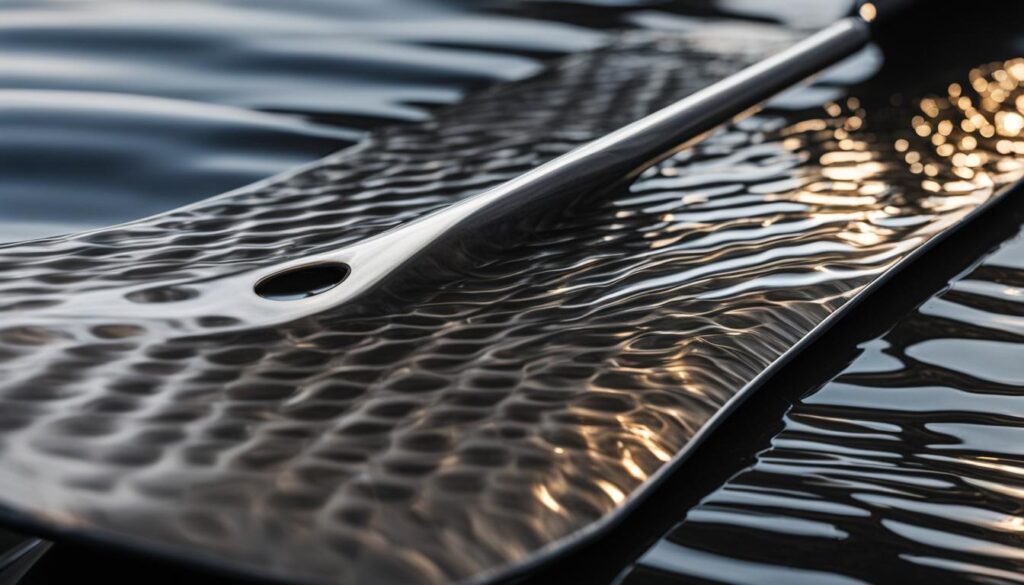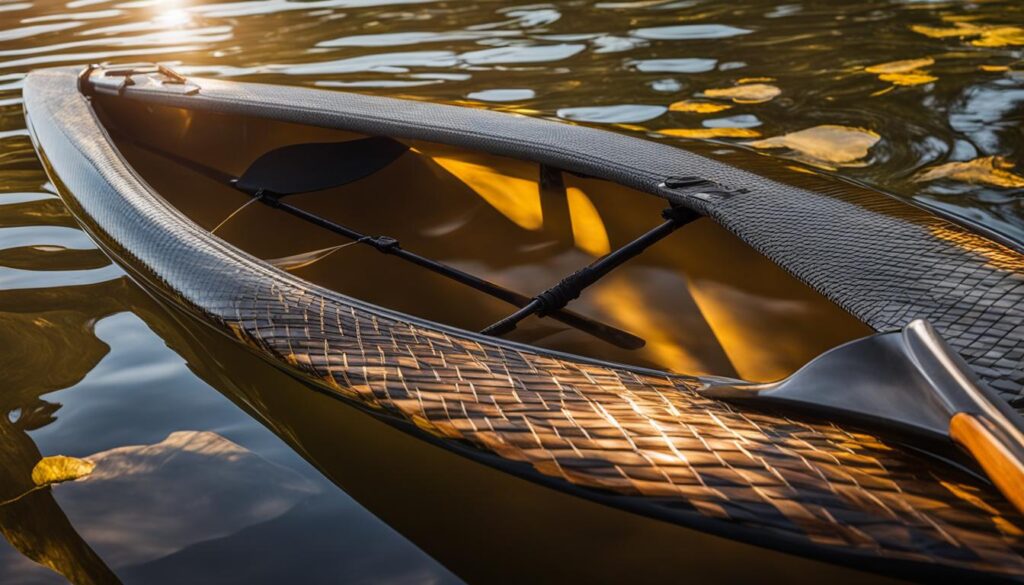When it comes to choosing a kayak paddle, one important factor to consider is the durability of the materials used. The right paddle material can make a significant difference in the longevity and performance of your paddle. With various options available, such as plastic, aluminum, wood, fiberglass, and carbon fiber, it’s essential to understand which material is best suited for your kayaking needs.
Key Takeaways:
- Paddle material durability is crucial for long-lasting performance.
- Plastic and aluminum paddles are suitable for beginners or those on a budget.
- Wood, fiberglass, and carbon fiber paddles offer greater durability and performance.
- Carbon fiber paddles are the lightest and most high-performance option.
- Proper maintenance, including regular rinsing and sun protection, can prolong the life of your paddle.
Plastic Paddles
If you’re a beginner or on a tight budget, plastic paddles can be a suitable option for your kayaking adventures. These paddles are often sold as part of beginner’s kayaking packages and are an inexpensive choice. However, it’s important to note that plastic paddles are not as durable as other materials and may not hold up well to heavy use or longer sessions.
While plastic paddles are adequate for short distances and infrequent use, they can easily degrade in the sun. If you plan on kayaking regularly or tackling more challenging waters, you may want to consider a more durable paddle material. Plastic paddles can be a good starting point for beginners to get a feel for kayaking without investing a lot of money upfront.
“Plastic paddles are a cost-effective solution for beginners or those looking for a temporary paddle option. They may not offer the same level of durability as other materials, but they can still provide a satisfactory experience for casual kayakers.” – KayakingPro Magazine
For those who are just starting out in kayaking, plastic paddles can suffice as you learn the basics and gain confidence on the water. However, if you plan to make kayaking a regular hobby or are looking for a more durable option, you may want to explore other paddle materials that offer increased longevity and performance.
| Paddle Material | Durability | Cost | Weight |
|---|---|---|---|
| Plastic | Low | Inexpensive | Light |
| Aluminum | Medium | Reasonable | Heavy |
| Wood | Medium to High | Varies | Varies |
| Fiberglass | High | Moderate | Light |
| Carbon Fiber | High | Expensive | Very Light |
Aluminum Paddles
When it comes to lightweight and durable paddle materials, aluminum is a top choice for kayakers. Aluminum paddles offer a good balance between durability and affordability, making them a popular option for beginner and intermediate paddlers.
One of the key advantages of aluminum paddles is their durability. They can withstand light damage better than plastic paddles and are less prone to degradation in the sun. This makes aluminum paddles suitable for regular use and longer trips, providing peace of mind that your paddle will hold up well over time.
However, it’s important to note that aluminum paddles tend to be heavier compared to other materials. This additional weight can make paddling more challenging, especially during longer excursions or in whitewater conditions. If you’re planning on frequent or intense kayaking sessions, you may want to consider lighter options such as fiberglass or carbon fiber paddles.
| Advantages of Aluminum Paddles | Disadvantages of Aluminum Paddles |
|---|---|
|
|
In conclusion, aluminum paddles are a great option for those looking for a balance between durability and affordability. They are a reliable choice for regular kayaking outings and longer trips. However, if you prioritize lightweight and high-performance materials, alternatives such as fiberglass or carbon fiber paddles may be more suitable. Consider your kayaking needs and preferences to make an informed decision about the best paddle material for your adventures on the water.

Wood, Fiberglass, and Carbon Fiber Paddles
When it comes to high-performance kayak paddle materials, wood, fiberglass, and carbon fiber paddles are the top choices. Each material offers its own unique advantages and considerations, making them suitable for different types of kayakers.
Wood Paddles
Wood paddles are renowned for their combination of durability and aesthetics. They are often made from various types of wood, such as cedar or birch, which can affect their weight and performance. While wood paddles may be slightly heavier than other materials, they compensate with their excellent durability and ability to withstand abuse. They are a popular choice for those who value a classic and natural look. However, wood paddles may not be the most lightweight option for intense whitewater kayaking or frequent outings.
Fiberglass Paddles
Fiberglass paddles are known for their strength and relatively light weight. They are made by reinforcing fiberglass fibers with resin, resulting in a robust and impact-resistant paddle. Fiberglass paddles offer excellent performance in a variety of conditions and are suitable for both recreational and touring kayakers. They provide a good balance between weight, durability, and affordability.
Carbon Fiber Paddles
Carbon fiber paddles are the pinnacle of high-performance kayak paddle materials. They are incredibly lightweight, making them the preferred choice for competitive and experienced kayakers. Carbon fiber paddles are made by weaving carbon fibers together and then combining them with resin. This construction method results in a paddle that is extremely strong, stiff, and efficient in the water. While carbon fiber paddles offer unmatched performance, they are also the most expensive option.
Overall, wood, fiberglass, and carbon fiber paddles are excellent choices for kayakers seeking high-performance materials. Wood paddles provide durability and a natural look, while fiberglass paddles offer a good balance of strength and weight. Carbon fiber paddles are the lightest and most advanced option for those looking to maximize performance. Consider your kayaking style, budget, and preferences to determine which material is the best fit for your needs.

Table: Comparison of Wood, Fiberglass, and Carbon Fiber Paddles
| Material | Durability | Weight | Performance | Cost |
|---|---|---|---|---|
| Wood | Excellent | Slightly heavier | Good | Moderate |
| Fiberglass | Strong | Lightweight | Very good | Affordable |
| Carbon Fiber | Very strong | Ultra-lightweight | Excellent | Expensive |
Conclusion
Choosing a durable paddle material is crucial for long-lasting performance and enjoyment on the water. Plastic and aluminum paddles are suitable for beginners or those on a budget, but may not hold up well to heavy use. Wood, fiberglass, and carbon fiber paddles offer greater durability and performance, with carbon fiber being the lightest and most high-performance option.
Proper maintenance of your paddle is essential to ensure its longevity, regardless of the material. To keep your paddle in top condition, rinse it regularly with fresh water after each use to remove any salt or dirt that may cause damage. Avoid leaving your paddle in direct sunlight for extended periods as UV rays can degrade certain materials over time.
Additionally, consider storing your paddle in a cool, dry place when not in use. Extreme temperatures and humidity can affect the integrity of the paddle’s materials. Using protective covers or bags can also help prevent scratches and dings during transportation or storage.
By following these maintenance tips and considering the different paddle materials and their characteristics, you can make an informed decision and find the best paddle for your kayaking adventures. Invest in a long-lasting paddle, take care of it, and you’ll be able to enjoy countless hours paddling on the water for years to come.
FAQ
What are the most durable kayak paddle materials?
The most durable kayak paddle materials include wood, fiberglass, and carbon fiber.
Are plastic paddles suitable for beginners?
Yes, plastic paddles are a popular choice for beginners due to their affordability.
Are plastic paddles durable?
Plastic paddles are not as durable as other materials and can degrade easily in the sun.
Are aluminum paddles lightweight?
No, aluminum paddles tend to be quite heavy, which can make paddling more difficult.
Are wood paddles suitable for whitewater kayaking?
Wood paddles are durable but may not be the best option for heavy use in whitewater.
Which paddle material is the most high-performance?
Carbon fiber paddles are the lightest and offer the highest performance.
How can I properly maintain my paddle?
Regular rinsing and avoiding exposure to the sun can help prolong the life of your paddle.





